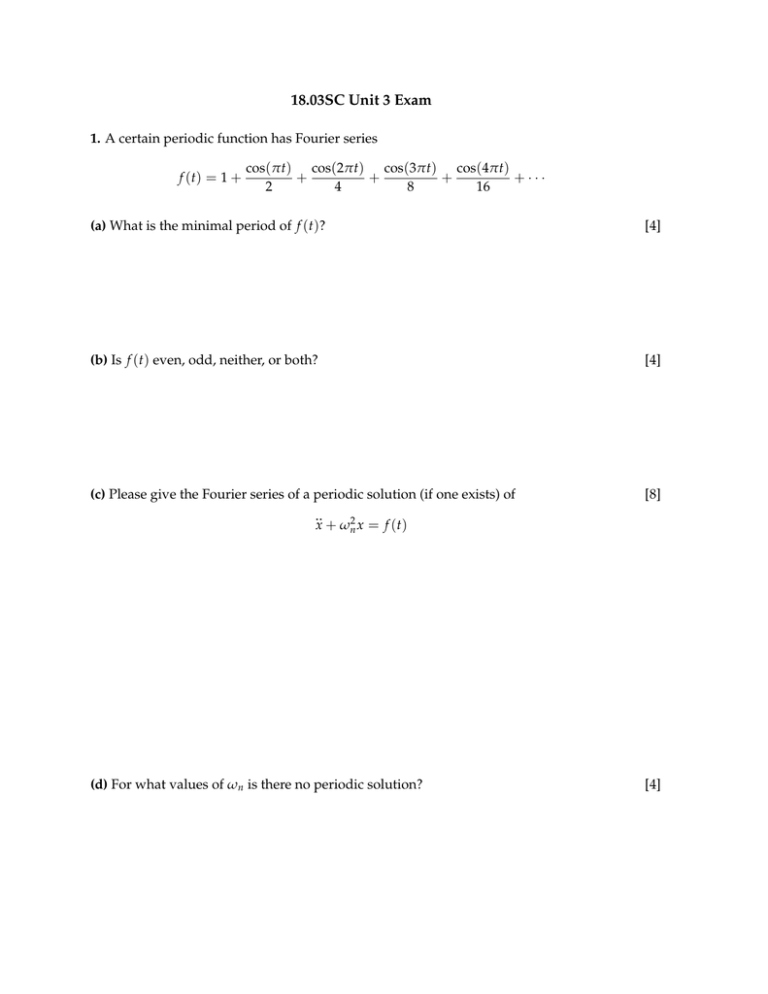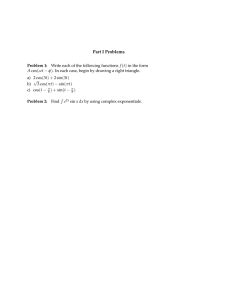18.03SC Unit 3 Exam ( ) · · ·
advertisement

18.03SC Unit 3 Exam 1. A certain periodic function has Fourier series f (t) = 1 + cos(πt) cos(2πt) cos(3πt) cos(4πt) + + + +··· 2 4 8 16 (a) What is the minimal period of f (t)? [4] (b) Is f (t) even, odd, neither, or both? [4] (c) Please give the Fourier series of a periodic solution (if one exists) of [8] .. x + ωn2 x = f (t) (d) For what values of ωn is there no periodic solution? [4] 18.03SC Unit 3 Exam OCW 18.03SC 2. Let f (t) = (u(t + 1) − u(t − 1))t. (a) Sketch a graph of f (t). [6] (b) Sketch a graph of the generalized derivative f � (t). [6] (c) Write a formula for the generalized derivative f � (t). [8] 2 18.03SC Unit 3 Exam OCW 18.03SC 3. Let p( D ) be the operator whose unit impulse response is given by w(t) = e−t − e−3t . (a) Using convolution, find the unit step response of this operator: the solution to p( D )v = [10] u(t) with rest initial conditions. (b) What is the transfer function W (s) of the operator p( D )? [5] (c) What is the characteristic polynomial p(s)? [5] 3 18.03SC Unit 3 Exam OCW 18.03SC 4 (a) Find a generalized function f (t) with Laplace transform F (s) = (b) Find a function f (t) with Laplace transform F (s) = 4 e − s ( s − 1) . s s + 10 . s3 + 2s2 + 10s [10] [10] 18.03SC Unit 3 Exam 5. Let W (s) = OCW 18.03SC s + 10 . s3 + 2s2 + 10s (a) Sketch the pole diagram of W (s). [10] (b) If W (s) is the transfer function of an LTI system , what is the Laplace transform of the [10] response from rest initial conditions to the input sin(2t)? 5 18.03SC Unit 3 Exam OCW 18.03SC Properties of the Laplace transform � ∞ f (t)e−st dt 0. Definition: L[ f (t)] = F (s) = 1. Linearity: L[ a f (t) + bg(t)] = aF (s) + bG (s). 2. Inverse transform: F (s) essentially determines f (t). 3. s-shift rule: L[e at f (t)] = F (s − a). 0− e−as F (s), for Re s >> 0. � f a (t) = u(t − a) f (t − a) = f (t − a) if t > a . 0 if t < a 4. t-shift rule: L[ f a (t)] = 5. s-derivative rule: L[t f (t)] = − F � (s). 6. t-derivative rule: L[ f � (t)] = sF (s) − f (0− ), where f � (t) denotes the generalized derivative. 7. Convolution rule: L[ f (t) ∗ g(t)] = F (s) G (s), f (t) ∗ g(t) = 8. Weight function: L[w(t)] = W (s) = 1/p(s), w(t) the unit impulse response. � t+ 0− f (t − τ ) g(τ )d τ. Formulas for the Laplace transform L[1] = 1 s L[e at ] = s + ω2 2ω s L[t cos(ωt)] = 2 ( s + ω 2 )2 L[cos(ωt)] = 1 s−a L[tn ] = n! s n +1 ω + ω2 s2 − ω 2 L[t sin(ωt)] = 2 ( s + ω 2 )2 L[sin(ωt)] = s2 s2 Fourier coefficients for periodic functions of period 2π: f (t) = a0 + a1 cos(t) + a2 cos(2t) + · · · + b1 sin(t) + b2 sin(2t) + · · · 2 am = 1 π � π −π f (t) cos(mt) dt, bm = 1 π � π −π f (t) sin(mt) dt If sq(t) is the odd function of period 2π which has value 1 between 0 and π, then � � 4 sin(3t) sin(5t) sq(t) = sin(t) + + +··· π 3 5 6 MIT OpenCourseWare http://ocw.mit.edu 18.03SC Differential Equations�� Fall 2011 �� For information about citing these materials or our Terms of Use, visit: http://ocw.mit.edu/terms.





